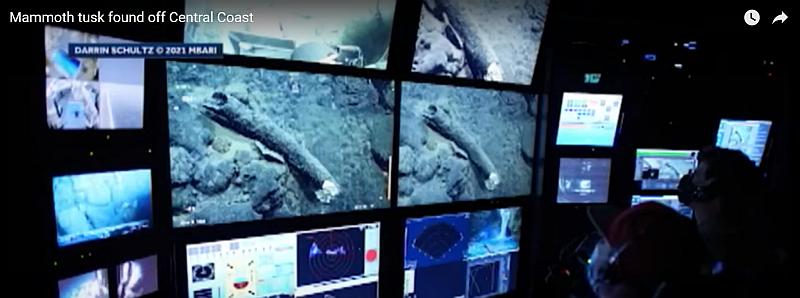 Interesting news from the Monterey Bay Aquarium Research Institute (MBARI).
Interesting news from the Monterey Bay Aquarium Research Institute (MBARI).
While exploring a seamount by ROV from aboard the R/V Western Flyer in 2019 the MBARI team spotted what looked like an elephant’s tusk. The seamount is located 300 kilometers (185 miles) offshore of California and is 3,070 meters (10,000 feet) deep.
Only able to collect a small piece at the time, MBARI returned in July 2021 to retrieve the complete specimen. Now researchers are examining the tusk and have confirmed that the tusk—about one meter (just over three feet) in length—is from a Columbian mammoth (Mammuthus columbi). The cold, high-pressure environment of the deep sea uniquely preserved the tusk, giving researchers the opportunity to study it in greater detail. Computed tomography (CT) scans will reveal the full three-dimensional internal structure of the tusk and more information about the animal’s history, such as its age.
“This specimen’s deep-sea preservational environment is different from almost anything we have seen elsewhere,” said University of Michigan paleontologist Daniel Fisher, one of the researchers studying the tusk, who specializes in the study of mammoths and mastodons. “Other mammoths have been retrieved from the ocean, but generally not from depths of more than a few tens of meters.”
MBARI reports that the research team believes it could be the oldest well-preserved mammoth tusk recovered from this region of North America. Dating of the tusk is being done by the UCSC Geochronology Lab led by Terrence Blackburn, associate professor of Earth and planetary sciences. Blackburn analyzed radioisotopes to show that the tusk is much more than 100,000 years old. “Our age estimate on the tusk is largely based on the natural radioactive decay of certain uranium and thorium isotopes imparted to the tusk from the ocean.
But how did a mammoth tusk end up on a seamount 10,000 feet below the surface? Annie Roth writing in The New York Times has one possible explanation:
A young female mammoth was wandering long ago near what would become the Central Coast of California, when her life came to an untimely end. Although she died on land, her massive body found its way into the Pacific Ocean. Carried by currents, her remains drifted more than 150 miles from shore before settling 10,000 feet beneath the water’s surface on the side of a seamount. There she sat for millenniums, her existence known to no one.
Until at least the tusk was retrieved by MBARI.

Cause of death, drowning? 🙂